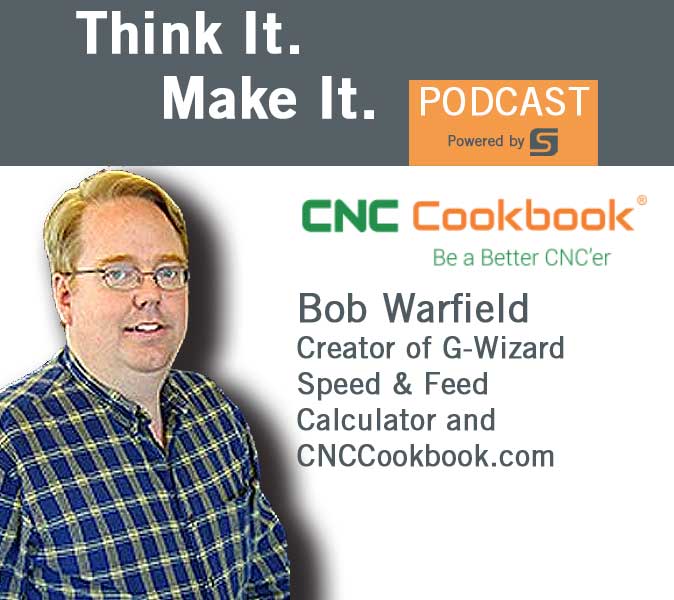Podcast: Play in new window | Download
Bob Warfield is a proven CNC expert and is the creator of www.CNCCookbook.com and the very popular G-Wizard Speed and Feed Calculator software. We are thankful for Bob taking the time to discuss his software, speeds and feeds and much more.
Bob discusses how he started CNCCookbook and what led him to starting the G-Wizard Calculator which started around 2007, which he wrote entirely on his own. He designed this software to accomplish three things:
– To be the world’s best speeds and feeds calculator
– Help people remember tips, which are built into the program
– Wanted software that would optimize the numbers
We also discussed using CAD/CAM Wizards to generate a solid starting point for your feeds and speeds when setting up a job by answering a few questions in the wizard and it will give you a complete recipe for performing that CNC operation.
We also discuss tips for cutting aluminum on CNC router machines.
We discuss the effects of rubbing and excessive heat and how it adversely affects how the CNC cuts as well as shortening cutter life.
Chip clearing is very important in a CNC job as well because the heat is extracted from the end mill and material and is carried away in the chips.
We discuss the very popular topic of Climb vs. Conventional cutting.
We discuss using your ear to listen for the best speeds and feeds settings, and how this is not the best way to setup your machine.
We also discuss chatter, what causes it and how do diagnose it.
SPECIAL PRICING UNTIL JULY 1, 2019
Save $10 off a 1 Year Subscription to G-Wizard
Visit www.stepcraft.us/gwizard for more info
LINKS
CNCCookbook.com
G-Wizard Speed and Feed Calculator
Titans Of CNC
Winston Moy (YouTube)
Article – 11 Easy CNC Router Aluminum Cutting Tips
Amana Tool


Assuming the machine can handle it, shouldn’t the speed and feed recommendations provided by the cutter manufacturers provide the best performance and longest life for the cutters?
Yes and no.
Manufacturers will tell you their recommendations are a starting point. They will also often provide ranges of numbers,
and very little guidance as to how to choose exactly where in the range to use.
You can’t blame them, it’s very hard to provide the answers to a many-dimensional problem in a very few 2 dimensional tables. For example, the G-Wizard Calculator
considers 60 different variables when it recommends feeds and speeds. There’s no way to capture that in 2 dimensional tables.
Think of the Manufacturer’s recommendations as being the answer if everything goes perfectly. Then think of a Calculator like G-Wizard as adjusting those recommendations
for everything that is not perfect, such as:
– Chip Thinning
– Adjust for High Speed Machine toolpaths such as Adaptive Clearing
– Fine Adjustments based on Cut Width and Cut Depth (not to mention helping you optimize those variables)
– Adjusting feeds and speeds for machine limits including max and min rpms, max feedrate, and machine rigidity
– Dealing with tool deflection
– Adjust for finish vs roughing passes
Those are just a few examples you mostly don’t see covered in manufacturer’s catalogs. But they all matter to your tool life and cutter productivity.
– Reply per Bob Warfield
“Manufacturers will tell you their recommendations are a starting point. They will also often provide ranges of numbers, and very little guidance as to how to choose exactly where in the range to use.” I would assume that manufacturers like Amana, which also make specialized saw blades for cutting a variety of materials properly, would provide the best guidance on their use. My take away from the Podcast is that GWizard totally ignores that guidance and that Amana may even be using GWizard to generate their speeds and feeds recommendations! Is that correct?
IMO this video https://www.youtube.com/watch?v=_N5VaTchhys demonstrates the value of both adaptive clearing and the use of spindles that are quiet enough to enable monitoring of milling sounds by the operator. Also, note that even milling at 100,000 RPM with 2 flute endmills is easily audible. (100,000 revolutions per minute X 2 beats per revolution / 60 seconds per minute = 3,333 beats per second (Hz).
Wow! this is an amazing things about CNC, your article is very helpful and lots of information for CNC services.
Thank for the sharing article.